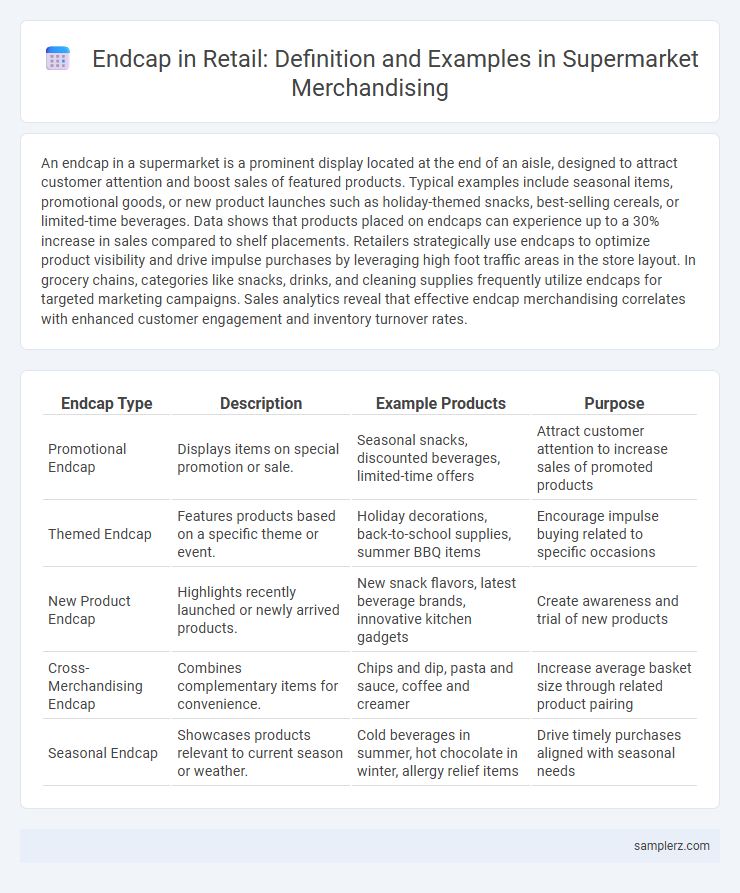An endcap in a supermarket is a prominent display located at the end of an aisle, designed to attract customer attention and boost sales of featured products. Typical examples include seasonal items, promotional goods, or new product launches such as holiday-themed snacks, best-selling cereals, or limited-time beverages. Data shows that products placed on endcaps can experience up to a 30% increase in sales compared to shelf placements. Retailers strategically use endcaps to optimize product visibility and drive impulse purchases by leveraging high foot traffic areas in the store layout. In grocery chains, categories like snacks, drinks, and cleaning supplies frequently utilize endcaps for targeted marketing campaigns. Sales analytics reveal that effective endcap merchandising correlates with enhanced customer engagement and inventory turnover rates.
Table of Comparison
| Endcap Type | Description | Example Products | Purpose |
|---|---|---|---|
| Promotional Endcap | Displays items on special promotion or sale. | Seasonal snacks, discounted beverages, limited-time offers | Attract customer attention to increase sales of promoted products |
| Themed Endcap | Features products based on a specific theme or event. | Holiday decorations, back-to-school supplies, summer BBQ items | Encourage impulse buying related to specific occasions |
| New Product Endcap | Highlights recently launched or newly arrived products. | New snack flavors, latest beverage brands, innovative kitchen gadgets | Create awareness and trial of new products |
| Cross-Merchandising Endcap | Combines complementary items for convenience. | Chips and dip, pasta and sauce, coffee and creamer | Increase average basket size through related product pairing |
| Seasonal Endcap | Showcases products relevant to current season or weather. | Cold beverages in summer, hot chocolate in winter, allergy relief items | Drive timely purchases aligned with seasonal needs |
Overview of Endcap Displays in Supermarkets
Endcap displays in supermarkets showcase high-demand or seasonal products at the end of aisles, maximizing visibility and driving impulse purchases. These strategically positioned displays highlight promotional items, such as new snacks, beverages, or holiday goods, effectively increasing product turnover and boosting sales. Retailers leverage endcap placement to guide customer traffic flow and enhance overall shopping experience by emphasizing key merchandise.
Popular Product Types Featured on Endcaps
Endcaps in supermarkets frequently showcase popular product types such as snacks, seasonal items, and beverages to capture shopper attention and drive impulse buys. Items like chips, candy, bottled drinks, and holiday-themed products are strategically placed to increase visibility and sales. Prominently displayed endcaps featuring best-selling health foods or new product launches also contribute to enhanced consumer engagement.
Seasonal Endcap Display Examples
Seasonal endcap displays in supermarkets often feature themed products tied to holidays or weather changes, such as pumpkin spice items and Halloween decorations in the fall or sunscreen and beach toys during summer. These strategically placed endcaps maximize visibility and encourage impulse buying by showcasing relevant seasonal merchandise in high-traffic areas. Retailers use vibrant signage and coordinated packaging to attract shoppers and boost sales during peak seasonal shopping periods.
Effective Endcap Placement Strategies
Effective endcap placement strategies in supermarkets prioritize high-traffic aisles and product categories with strong impulse-buy potential, such as snacks, beverages, and seasonal items. Positioning endcaps near checkout lines or entranceways maximizes product visibility and encourages last-minute purchases. Utilizing vibrant signage and strategically grouping complementary products further enhances consumer engagement and drives sales.
The Role of Endcaps in Boosting Impulse Purchases
Endcaps in supermarkets function as strategic product displays positioned at the end of aisles, designed to capture shopper attention and encourage spontaneous buying decisions. These high-visibility placements often feature seasonal items, promotions, or new products, effectively increasing product turnover and average basket size. Research shows endcaps can boost impulse purchases by up to 20%, making them crucial for maximizing retail sales performance.
Endcap Success Stories from Leading Supermarkets
Leading supermarkets like Walmart and Kroger have leveraged endcaps to significantly boost sales by featuring seasonal products and limited-time offers, driving up to a 30% increase in category revenue. Target's strategic placement of health-conscious snacks on endcaps during wellness campaigns resulted in a 25% rise in impulse purchases. Tesco's use of visually appealing endcaps for new product launches has enhanced customer engagement and elevated brand visibility, demonstrating the power of targeted merchandising in retail environments.
Creative Thematic Endcap Concepts
Creative thematic endcap concepts in supermarkets enhance customer engagement by blending seasonal trends, product storytelling, and immersive visuals. Examples include holiday-themed displays featuring coordinated decor and curated products, or health-focused zones showcasing fresh produce alongside wellness items with informative signage. These innovative endcaps drive impulse purchases and elevate the overall shopping experience through targeted, visually appealing layouts.
Endcap Design Best Practices
Effective endcap design in supermarkets maximizes product visibility and drives impulse purchases by incorporating clear signage, strategic lighting, and bold color contrasts. Placing high-demand or seasonal items at eye level enhances shopper engagement and encourages quick decision-making. Utilizing modular layouts and clean organization ensures easy restocking and maintains a visually appealing display that supports overall store aesthetics.
Leveraging Endcaps for New Product Launches
Supermarkets leverage endcaps to maximize visibility and sales during new product launches by placing featured items at these high-traffic locations. Endcaps enable strategic product placement, capturing shopper attention and driving impulse purchases through eye-level displays and prominent signage. Data shows new products positioned on endcaps experience a 20-30% increase in sales compared to standard shelf placement.
Case Studies: High-Performing Endcap Campaigns
A prominent case study of high-performing endcap campaigns in retail features Coca-Cola's limited-time holiday packaging, which increased sales by 25% within two weeks at Walmart stores nationwide. Target's strategic placement of seasonal snacks on endcaps during Halloween resulted in a 30% boost in category sales, driven by impulse purchases and enhanced product visibility. These campaigns demonstrate the effectiveness of using endcaps to capitalize on seasonal trends and shopper behavior to drive significant sales uplift.

example of endcap in supermarket Infographic
 samplerz.com
samplerz.com